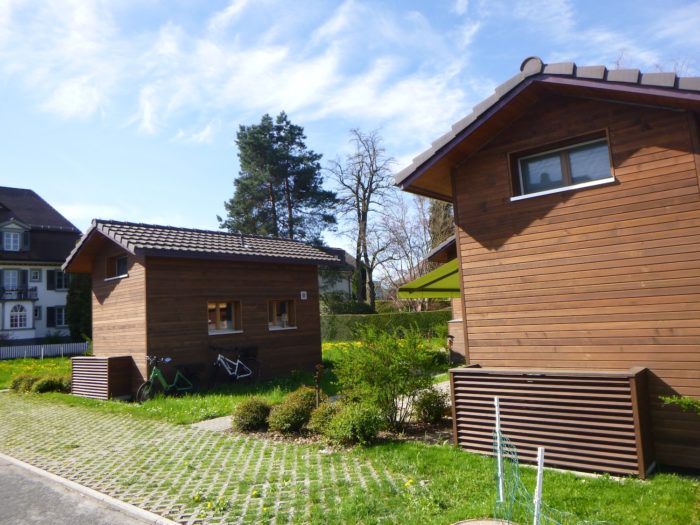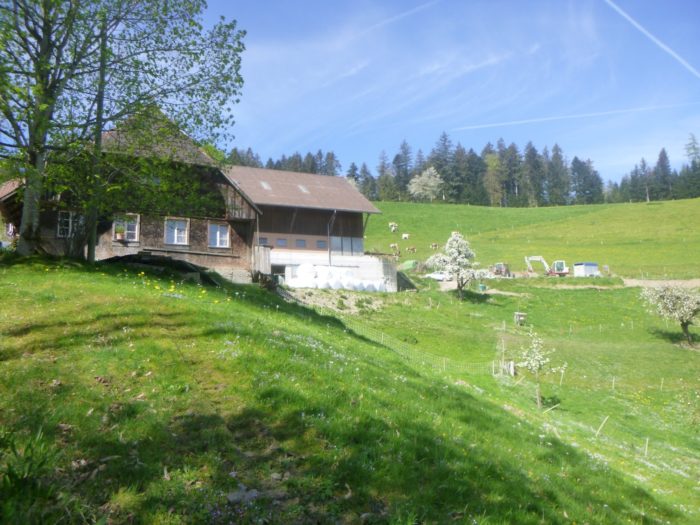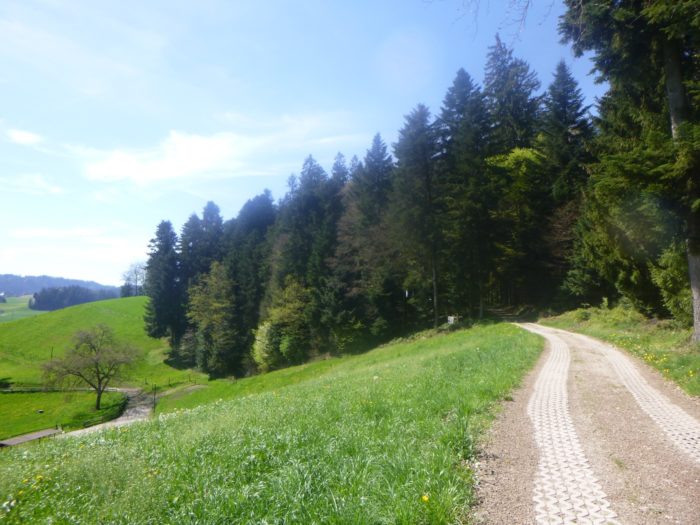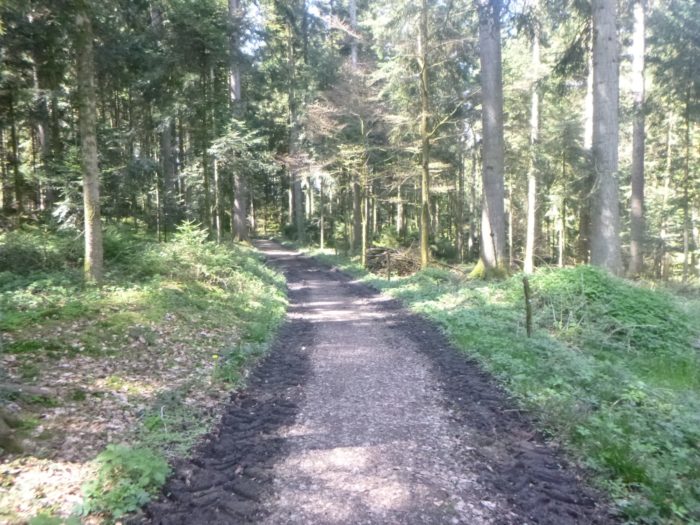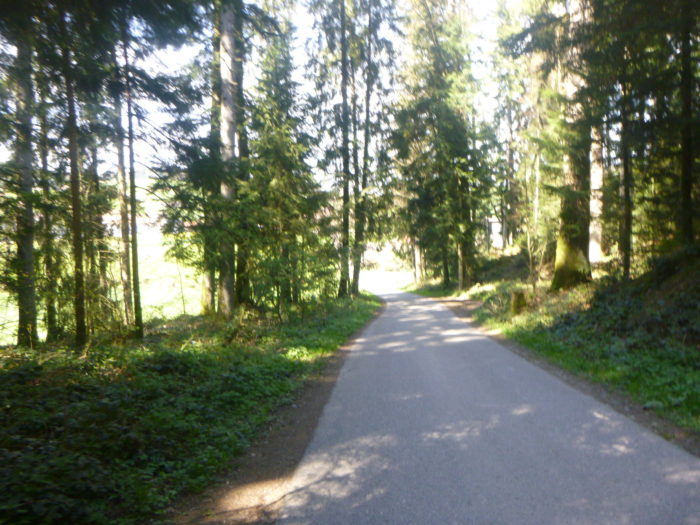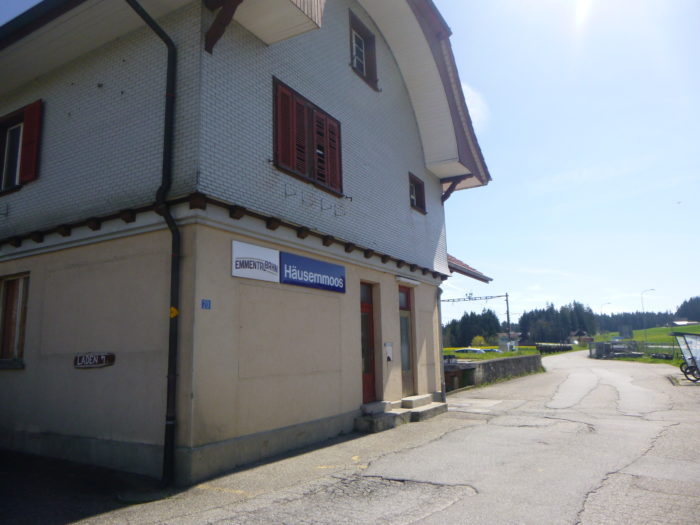In the heart of Emmental
DIDIER HEUMANN, ANDREAS PAPASAVVAS

We divided the course into several sections to make it easier to see. For each section, the maps show the course, the slopes found on the course, and the state of the route (paved or dirt roads). The courses were drawn on the « Wikilocs » platform. Today, it is no longer necessary to walk around with detailed maps in your pocket or bag. If you have a mobile phone or tablet, you can easily follow routes live.
For this stage, here is the link:
https://fr.wikiloc.com/itineraires-randonnee/de-huttwil-a-burgdorf-par-la-via-jacobi-4-136560515
|
Not all pilgrims are necessarily comfortable using GPS or navigating routes on a mobile device, and there are still many areas without an internet connection. For this reason, you can find several books on Amazon dedicated to the major Via Jacobi 4 route, which runs through the heart of Switzerland and over the Brünig Pass. The first guide leads pilgrims through the German-speaking part of Switzerland up to Fribourg, while the second continues through French-speaking Switzerland to Geneva. We have also combined these two books into a compact, lighter, and highly practical version. While the descriptions have been slightly condensed, they remain detailed enough to guide you step by step along the way. Recognizing the importance of traveling light, this latest edition has been designed to provide only the essentials: clear and useful information, stage by stage, kilometer by kilometer. The stages have been carefully adjusted to ensure accessibility and alignment with available lodging options. These books go beyond simple practical advice. They guide you kilometer by kilometer, covering all the crucial aspects for seamless planning, ensuring that no unexpected surprises disrupt your journey. But these books are more than just practical guides. They offer a complete immersion into the enchanting atmosphere of the Camino. Prepare to experience the Camino de Santiago as a once-in-a-lifetime journey. Put on a good pair of walking shoes, and the path awaits you.
|

|
 |
If you only want to consult lodging of the stage, go directly to the bottom of the page.
Today’s route traverses from Upper Aargau into Emmental, the region through which the Emme River flows, and the birthplace of Emmental cheese.

Emmental, or Emmentaler, is a hard cheese originating from Switzerland, named after the Emme Valley (Emmental in German) in the eastern part of the canton of Bern. The term « Emmental » is also used for similar cheeses produced industrially or under various labels in other countries. This cow’s milk cheese is known for its cooked pressed texture. The characteristic holes are caused by tiny hay particles that enter the milk during milking. During fermentation, these particles release gases that form the holes seen in the final product. A Swiss Emmentaler AOP cheese wheel typically weighs around 90 kg. The large size of these wheels dates back to the 19th century when customs duties were levied per unit rather than by weight. Generally, the cheese is aged for an average of seven weeks, but for a stronger flavor, it can be aged for 8 to 12 months. Emmental is one of the most consumed cheeses in Switzerland, alongside Gruyère, and is also one of the most widely known and exported cheeses globally. The production area includes the canton of Bern and many other Swiss-German cantons, extending to the German-speaking part of the canton of Fribourg. Emmental AOP is produced according to very specific guidelines, with approximately 149 companies in Switzerland currently producing Emmental AOC. Today, the production of Gruyère AOC slightly surpasses that of Emmental AOC. Nevertheless, Emmental AOC remains Switzerland’s most exported cheese, with twice the export volume of Gruyère AOC.
Swiss nationals often critique the production of these cheeses outside of Switzerland, similar to Gruyère cheese. Nowadays, industrial cheese similar to Emmental is produced under the generic name « Emmental » in Germany, Austria, Denmark, the United States, the Netherlands, and France. The total European industrial production is around 464,000 tons, representing about 6% of these countries’ milk collection, significantly more than Switzerland’s production of approximately 25,000 tons per year. Since 1999, France has been recognized as the world’s leading producer of this cheese, with about 110,000 tons annually, half of which is produced in Brittany. The feud between the Swiss and the French over cheese production is far from over. For a long time, French industrial Emmental was marketed in France under the generic name « Gruyère. » The confusion arose because, unlike Swiss Gruyère, French Gruyère contains holes, similar to Emmental. In the mid-19th century, Bernese merchants introduced Emmental to the French market as Gruyère, causing the mix-up. Despite Emmental being claimed as a French cheese, it has no French origin. The same story applies to Gruyère, also claimed by the French, but with holes, unlike Swiss Gruyère. This infuriates the Swiss, who rely on AOP labels to protect their products. The French, ever claiming to have invented everything, remain incorrigible. If one delves deeper, the cows’ diets should also be considered. In Switzerland, Simmental cows provide the milk, grazing on grass in summer and hay in winter. In France, mostly Holstein cows are used, which are typically kept indoors and fed corn. The choice is yours, gastronomes.

Difficulty level: The journey unfolds like a symphony of landscapes, oscillating between the majesty of forests and the tranquility of the countryside, featuring substantial elevation changes (+517 meters / -584 meters). There are two significant climbs. The first ascent, like a whisper from the awakening earth, gently rises towards the Kaltenegg hill, offering a slope both demanding and exhilarating, challenging the resolute to draw deep from their resilience to conquer the heights. Then, like a crescendo in this natural composition, the second climb appears, more imposing and grander, standing proudly at the heart of the route, leading towards the renowned tourist site of Lueg. But life, demanding as it is, is not just a series of ascents. After the effort, the reward comes in the form of a descent towards Burgdorf.
State of the Via Jacobi: In this stage, the paved roads slightly exceed the paths:
- Paved roads: 12.1 km
- Dirt roads : 10.7 km
Sometimes, for reasons of logistics or housing possibilities, these stages mix routes operated on different days, having passed several times on these routes. From then on, the skies, the rain, or the seasons can vary. But, generally this is not the case, and in fact this does not change the description of the course.
It is very difficult to specify with certainty the incline of the slopes, whatever the system you use.
For those seeking « true elevations » and enthusiasts of genuine altimetric challenges, carefully review the information on mileage at the beginning of the guide.

Section 1: Over the hills above Huttwil

Overview of the route’s challenges: a hilly route featuring a notable elevation.

|
At Huttwil station, a subtle fork marks the start of an adventure framed by two tracks, each carrying its own promise. To one side is Via Jacobi 4, carving its path towards Fiechten/Chaltenegg, and to the other, Via Jacobi 65, delving towards the horizons of Sumiswald. At first glance, their routes almost deceptively blend, but a closer look reveals a mere millimeter’s difference between these two destined tracks, a subtle but crucial nuance.
|
 |
 |
Kind guides, we direct you: Via Jacobi 65 leads towards urbanity, while th Via Jacobi 4 follows the rail route from the station, decisively heading towards Fiechten.

|
From the outset, the road crosses an abandoned railway, a relic of a time when it once snaked towards Burgdorf. Devoid of traffic for over two decades, this track is now a museum piece, with passenger transport entrusted to the wings of a bus. A heavy silence, tinged with nostalgia, hangs over this once vibrant artery.
|
 |
 |
| The road thus advances towards Fiechten, gradually distancing itself from urban arteries to flirt with the outskirts of the town. A parade of vacation chalets emerges, nestled like jewels in the countryside, while the symbolic omnipresence of the cow is revealed in frozen sculptures, silent witnesses to an ancestral way of life. |
 |
 |
The Via Jacobi 4, true to its course, blends harmoniously into the rural landscape, leaving behind the last houses to delve into the heart of farms and stately homes, adorned with their fine architectural presence.
|
 |
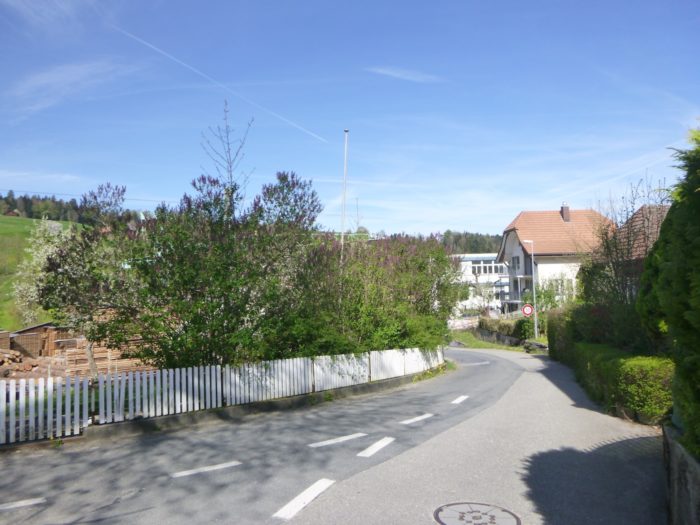 |
| A melodious echo resonates as the road skirts a large sawmill, a tangible symbol of the wood industry that has long embraced this region. |
 |
 |
| In Fiechten, the gentle murmur of the Rotbach stream accompanies the stroll, while homes, cloaked in shingles, stand proudly, their sloping roofs occasionally challenging the skies with a graceful curve. |
 |
 |
| PFurther on, the ascent begins, the road climbing towards the hill of Fiechtenberg. The steep slopes invite challenge. |
 |
 |
| Sometimes, only the cows, peaceful under the shade of trees, seem to sympathize with the effort of walkers, the trees offering their benevolent shade as comfort. |
 |
 |
| The road, paved with asphalt, snakes up to the hilltop, where it ends in a cul-de-sac at the edge of a farm of timeless beauty. |
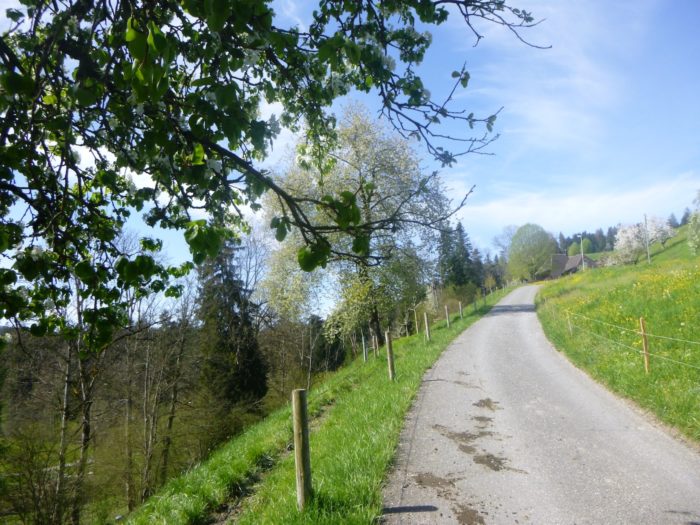 |
 |
Its enigmatic charm, bearing a history written in capital letters in a bygone High German, defies time and sparks the imagination of travelers, offering them a refuge at the crossroads.

| At the farm’s corner, a trail takes over and climbs in the meadows, flirting with the edge of the undergrowth, like a filigree of emerald edged with endless nuances. |
 |
 |
| Here, the landscape is adorned with enchanting greenery, where each blade of grass exhales the charm of a spring symphony. The path climbs the heights to meet another farm, perched like a jewel on the diadem of the hill. |
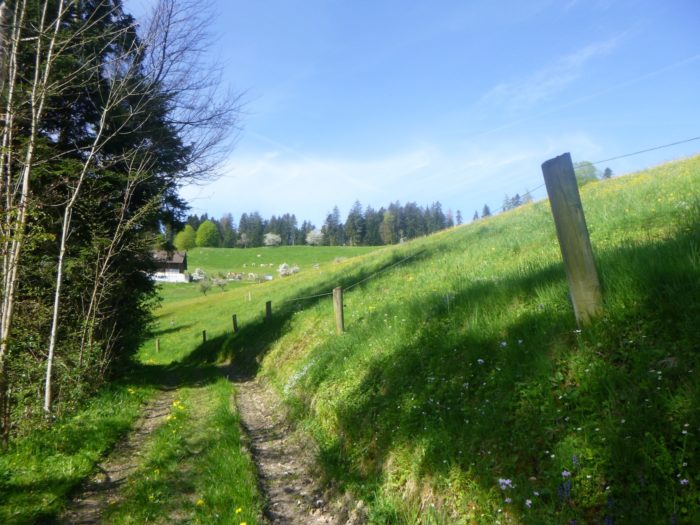 |
 |
| From this farm, the path winds in a graceful dance through the forest, its ascent taking more indulgent contours, like a gentle caress of nature. |
 |
 |
| Majestic spruces and beeches stand as sentinels, their branches intertwining in a millennia-old choreography, while here and there, a few rare oaks punctuate the horizon. |
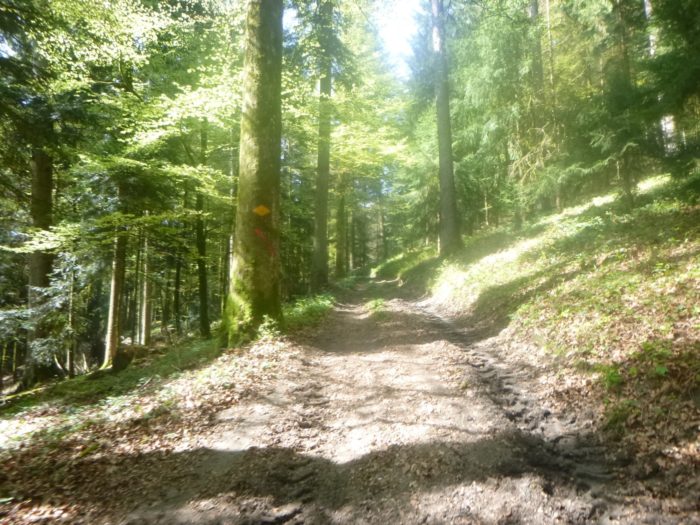 |
 |
| Higher up, the path emerges from the woods to embrace a sparse clearing, offering poetic pauses on the score of this ascent. |
 |
 |
| And behold, at the summit of the hill, near a splendid chalet at a place called Zwang, where the gaze delightfully loses itself in the valleys below, a scene worthy of the most beautiful postcards. It is still traditional Switzerland that presents itself for contemplation, with its verdant pastures, scattered woods, and farms sprinkled over the hills, like jewels scattered on an emerald carpet. |
 |
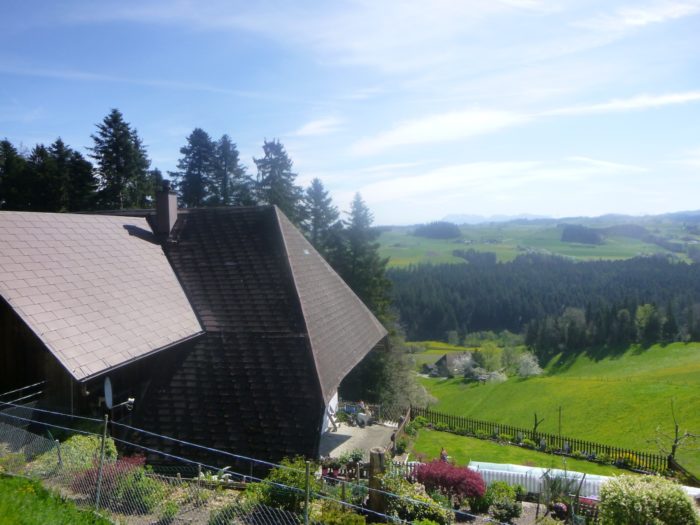 |
| Then, the path widens, gently descending through the countryside, overlooking the farms, grazing with its gaze the edge of the undergrowth. |
 |
 |
| After a brief sojourn among the foliage, the path capriciously dances through the fields. Soon covered in concrete squares, it refuses any constraint, preserving tractor access in a ballet of financial ease. |
 |
 |
| In this land, it is primarily pastures and cows that reign supreme, their peaceful silhouettes punctuating the landscape with their serene presence. But sometimes, through the green canvas, glimpses of culture, grains or rapeseed, appear as subtle notes in the pastoral symphony. |
 |
 |
| Soon after, the dirt road gives way to asphalt, climbing up to Kaltenegg, where imposing farms stand like fortresses built by man’s hand. |
 |
 |
At Kaltenegg, you reach an altitude of 762 meters, having cautiously climbed nearly 130 meters since Huttwil. Your next destination is Dürrenroth, where civilization looms on the horizon, just 30 minutes away.

Section 2: A picturesque village lies on the route before a vast forest

Overview of the route’s challenges: a hilly path featuring a notable descent and a steep climb through the village, followed by a trouble-free stretch.

| It is truly remarkable to observe that in the heart of this tranquilly captivating landscape, where only five to six farms dot the horizon, a cheese factory emerges as a powerful testament to the authenticity and richness of this region. The road, relentless, continues its climb on the hillside at the hamlet’s edge, rising gracefully amidst lush pastures. |
 |
 |
| At the summit of this majestic climb, the Via Jacobi leaves the asphalt road to merge into a path that delightfully descends towards the plain, where the uniform rooftops of Dürrenroth come into view. |
 |
 |
| The path winds through meadows, heading towards a promising undergrowth. |
 |
 |
|
However, the shade provided by the tree canopy is fleeting, and soon the path emerges into daylight at a place known as Chnubel. Here, the announcement of Santiago at 1380 kilometers resonates like a call to adventure, enveloping the traveler in a comforting echo.
|
 |
 |
|
Through orchards and fields, the path steeply descends amid fruit trees and patchy crops.
|
 |
 |
|
Its steep slope gradually reveals the proximity of the cantonal road.
|
 |
 |
The Via Jacobi then crosses this thoroughfare, directing towards the formerly bustling station, where the Rotbach quietly murmurs its crystalline song.
|
 |
 |
| One can easily imagine that boarding the train here was once a true delight, although the steep climb on the paved road to the village might discourage many. |
 |
 |
| The steep ascent culminates in a flight of stairs, offering from its summit a breathtaking view of the ancient temple that dominates the landscape. Dating back to the 15th century, this imposing structure has withstood the ages, enriched over time with numerous stories and legends. |
 |
 |

| Dürrenroth then unfolds in all its splendor, a village of rare beauty where noble homes compete in elegance. In fine weather, the restaurant terrace becomes a sought-after spot, coveted by travelers thirsty for enchanting panoramas and good food. |
 |
 |
| Among the treasures of this picturesque village, a cheese factory reigns supreme, bearing witness to the tradition and passion that animate this land. Yet, there is neither a grocery store nor a bakery here, in this realm of cheese, where artisanal craftsmanship is savored in every bite. |
 |
 |
| The Via Jacobi then escapes the confines of the village, unfolding peacefully along the road, gently sloping down to Gärbihof. The magnificent wooden chalets, silent witnesses of a secular past, dot the landscape with their timeless charm. Occasionally, the passage of a bus, the train’s modern successor, breaks the silence, reminding of modern advancements in this historic setting. |
 |
 |
| The road then runs through a village, where proud beautiful homes with meticulously maintained gardens stand. |
 |
 |
| At the corner of an ancestral farm, the Via Jacobi leaves the asphalt for a more rustic path. |
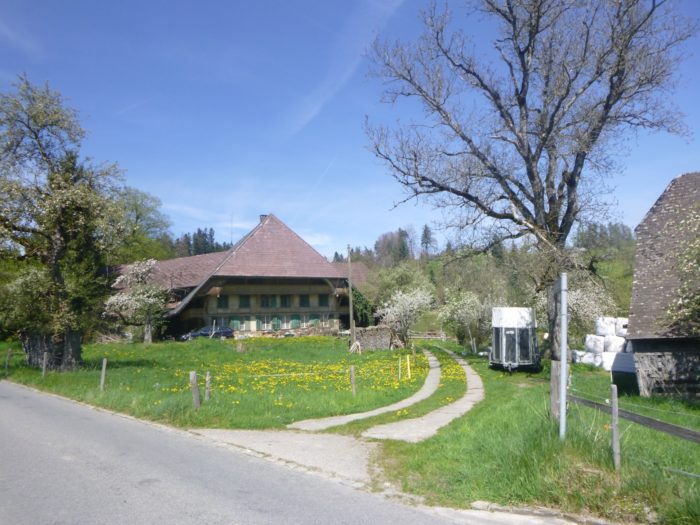 |
 |
| This path, gently caressing the wild herbs, soon heads towards the forest, where sometimes the Braunvieh, the iconic gray cows of Eastern Switzerland, make an appearance. |
 |
 |
| Here begins a two-kilometer wooded stroll through the majestic Rotwald Forest. |
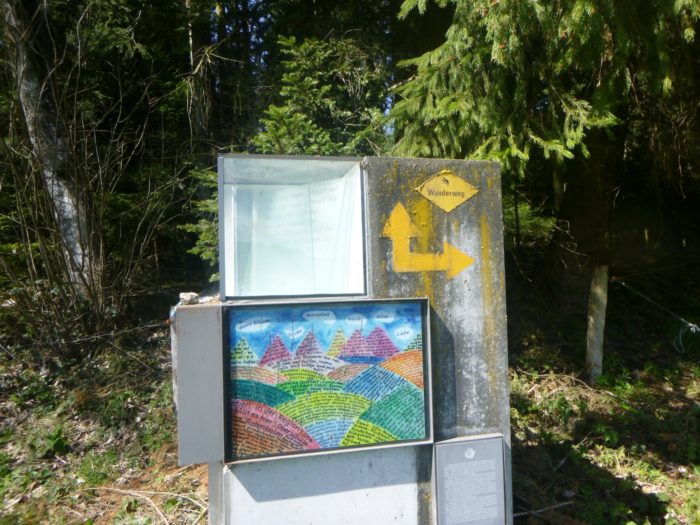 |
 |
| This serene, level walk unfolds in a dense yet airy forest, its broad paths inviting leisurely strolls, a common feature of Swiss woodlands. |
 |
 |
| At times, barriers of white fir trees present themselves, accompanied by majestic Douglas firs and imposing beech trees, creating a veritable plant ballet. |
 |
 |
| Further on, a path fork requires vigilance; in the absence of directional signs, one must watch for yellow diamonds on trees, marking the way forward. |
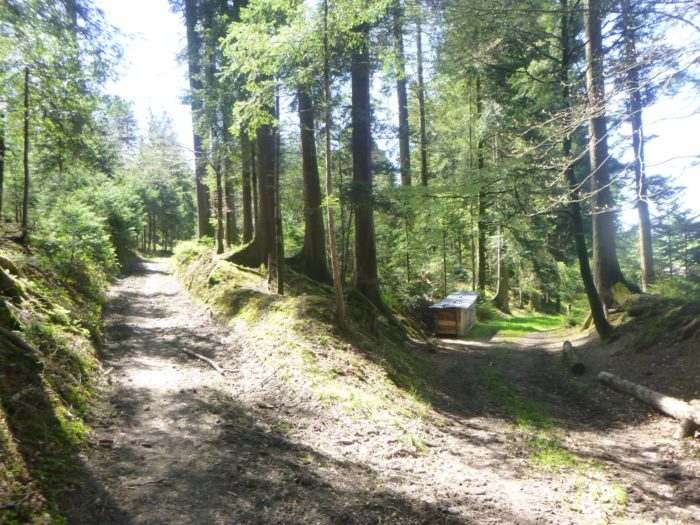 |
 |
Section 3: Amidst forests and beautiful countryside

Overview of the route’s challenges: a hilly route, often featuring steep inclines.

| The forest reveals itself in its finest attire, trees stretching their trunks towards the light, standing in rows like soldiers in search of the sun. |
 |
 |
| However, the path presents challenges, marked by horse tracks and furrows carved by forestry tractors, creating muddy passages even in dry weather. Detour paths bear witness to this persistent situation. |
 |
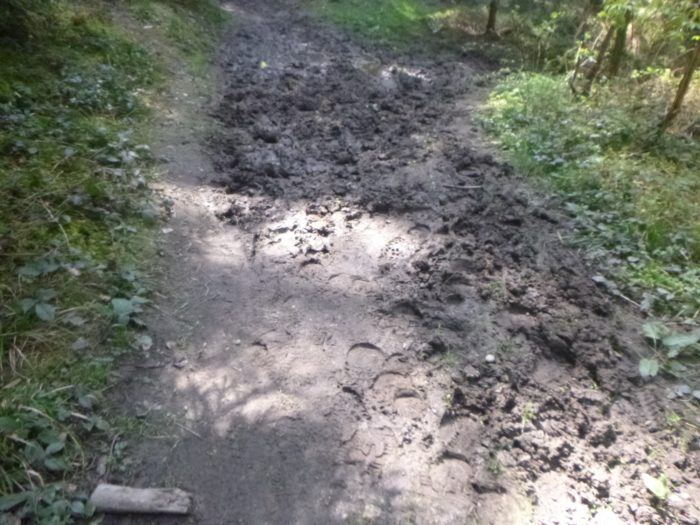 |
| Emerging from the forest’s embrace, clearings punctuate the landscape, offering views of the cantonal road and the abandoned railway, relics of a bygone era. |
 |
 |

| The path then leads into meadows, peacefully crossing the open space towards small hamlets scattered in the countryside. |
 |
 |
| The Via Jacobi then leaves the dirt path for a road that takes a right-angle turn towards Unterwaltrigen. |
 |
 |
| There lies a house with a remarkable garden, a living mural evoking the countless hours and resources invested in maintaining its splendor. |
 |
 |
| But beware of being too captivated by this beauty to the point of missing the fork and veering towards the tempting railway; just after this house, the path continues towards Häusernmoos, a half-hour’s walk away. |
 |
 |
| Continuing its journey, the Via Jacobi departs from the hamlet near a shed frequented by local youth and joyfully winds between meadows and the edges of woodlands. |
 |
 |
|
Soon, the village of Häusernmoos appears, nestled behind the small stream of Rotbach, meandering through the plain.
|
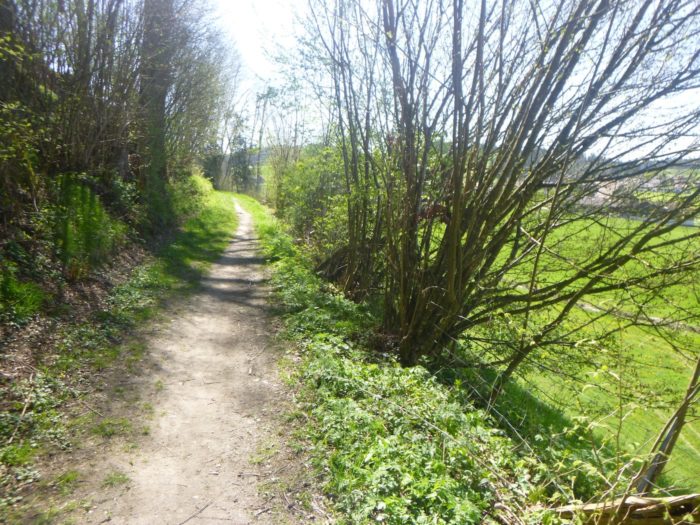 |
 |
| After passing by a relatively recent wooden house, the path navigates between meadows and hedges before encountering a small road that sharply descends towards the village. |
 |
 |
The road crosses the Rotbach and quickly leads to the Häusernmoos station. Although trains no longer pass through, a bus stop and an inn offer rest and dining options for travelers and hikers.
|
 |
 |
| The Via Jacobi takes the road to Herbrig, a relatively modern village compared to others in the region. |
 |
 |
Passing through Herbrig, you’ll notice an impressive mansion, although showing signs of decay, it proudly stands along the road. .

| Exiting the village, a path gently slopes up towards the forest. This part of the woods, sparse and exuding tranquility, offers a harmonious blend of conifers and deciduous trees. |
 |
 |
| The path crosses the Chapellebach stream on makeshift planks, briefly traversing meadows and cultivated fields before plunging back into the woods. |
 |
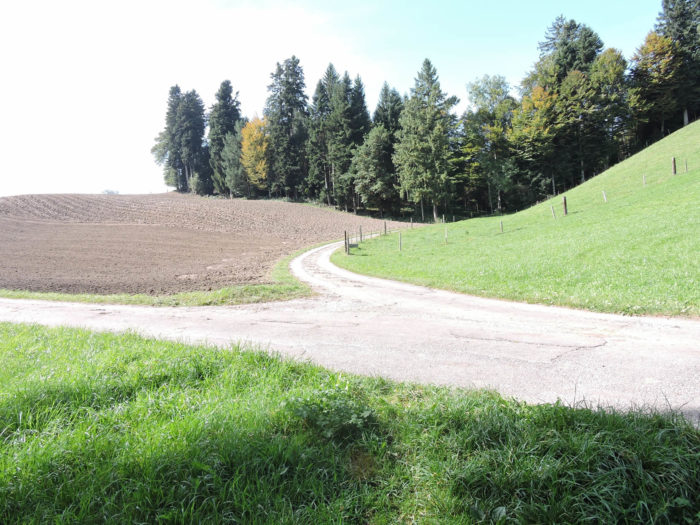 |
| The adventure continues with a return to the forest where the slope begins to steepen. The path leads to Lueg, winding through the forest on a road with cracked asphalt. Although the ascent is steady, it remains moderate, never exceeding a 10% incline. |
 |
 |
Section 4: Up on Lueg Hill

Overview of the route’s challenges : steep inclines both uphill and downhill.

| The path leads to a clearing where, near a large oak tree, it descends abruptly into the undergrowth. There, it winds along the bottom of a dale, passing beneath a majestic farmhouse situated high on the hillside of the Sack hamlet. |
 |
 |
| The path then slopes up more noticeably through the Juch forest, occasionally skirting the Oschbach stream amidst dense and wild vegetation. |
 |
 |
| Emerging from the forest, the path opens onto the Juch plateau where, during our passage, a multi-story building was under construction, which seems incongruous in a region dominated by agricultural holdings. |
 |
 |
| Then, the paved road gently descends towards Junkholz, a rural hamlet where one can spot a stray cow among sumptuous farms scattered in a tranquil landscape that invites effortless strolling. |
 |
 |
| A path, mixing grass and stones, then leads to the Luegwald Forest, passing just above Heiligenland, a hamlet whose name means « holy land, » a designation fully justified by the beauty of the place. |
 |
 |
| Further up, a trail climbs along the hillside, first through bare meadows, then through a wild grove. |
 |
 |
| It emerges into steep meadows where a memorial stands dedicated to 54 Bernese horsemen who died during the Spanish flu epidemic in 1918. The site offers a breathtaking panorama of the undulating landscapes of the Emmental, with the Bernese Alps and the Jura in the background, peaking at 890 meters, the highest point in the municipality of Affoltern in the Emmental. Historically, this place served as a lookout post where a warning fire could be lit in case of threat. |
 |
 |
| Descending, the trail reaches a heavily frequented parking lot by hikers and pilgrims during sunny weekends. |
 |
 |
| A road then descends towards the panoramic restaurant of Lueg, where walkers come to enjoy local specialties, including sausages and cheeses, accompanied by plenty of cream. |
 |
 |
| From the restaurant, a flat dirt road crosses the meadows. Looking back, there is a clear view of the hotel that not only offers meals but also wellness services, seminars, and even artistic events, including yodel concerts, and much more. |
 |
 |
|
The path continues to stretch out flat through the undergrowth, offering a moment of calm under the tree cover.
|
 |
 |
|
However, the route soon changes character, transforming into a steep descent that winds its way through the forest on a trail with slopes sometimes exceeding 35%. The ground, often held together by logs worn by time, bears witness to past attempts to stabilize the path. During rainy periods, this section becomes particularly challenging, turning the trail into a veritable quagmire of slippery clay, testing the skill and caution of hikers.
|
 |
 |
Section 5: Magnificent farms in nature

Overview of the route’s challenges: beyond the steep trail, mostly downhill, without significant difficulty.
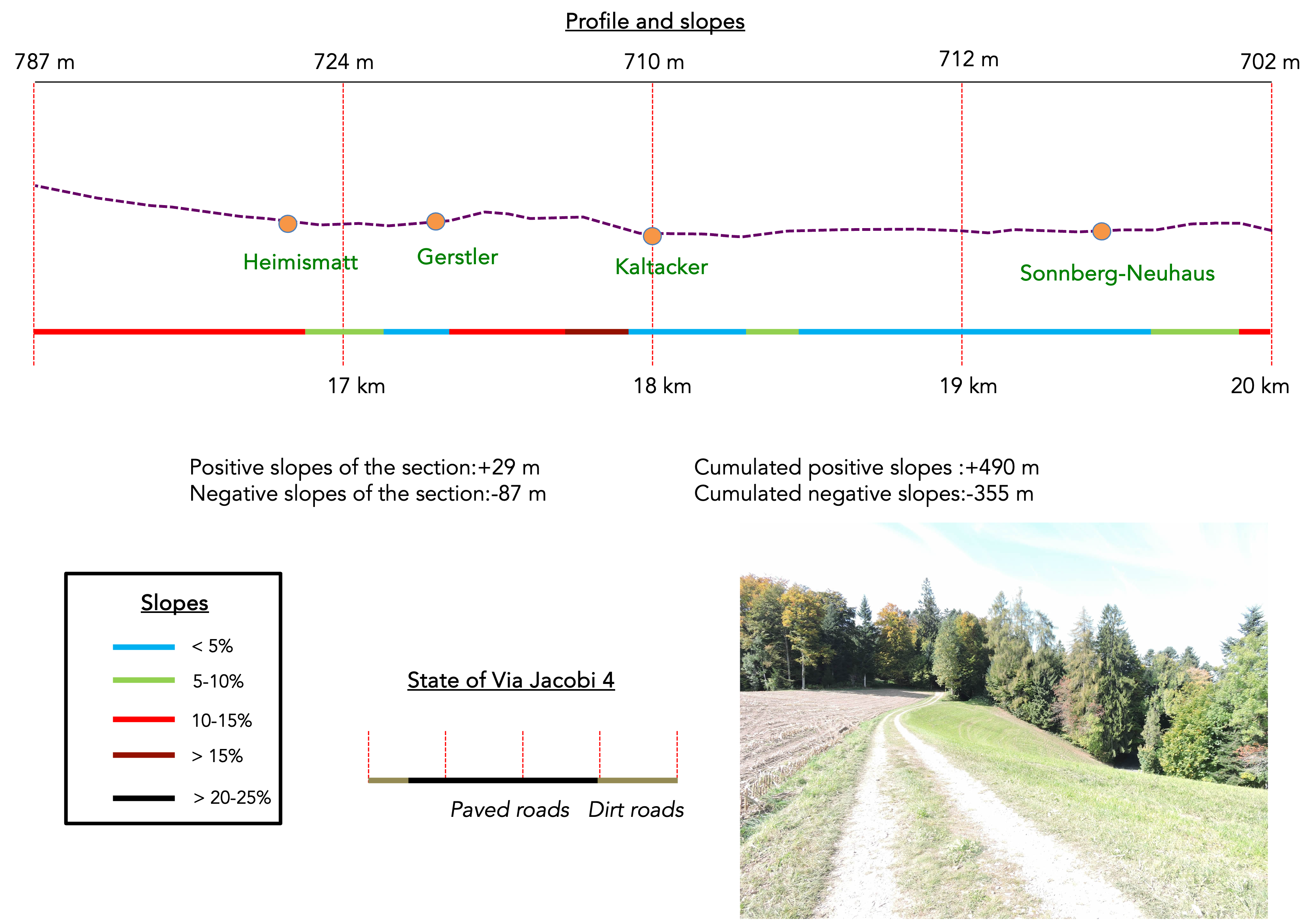
|
The descent, though short, challenges endurance with just over 300 meters of steep slope, cutting its way through untamed nature. There, the ground rebels underfoot, leaving walkers to struggle in a wild setting until the slope finally takes a breather at the edge of the woods.
|
 |
 |
|
At the bottom of this forest sanctuary, the slope softens like a sigh of the earth. The path, embraced by ancient trees, continues skirting the edge before blossoming onto the road that winds towards Lueg.
|
 |
 |
|
Then, a small paved road winds its way through the meadows towards Heimismatt, tracing arabesques on a carpet of greenery. Nature celebrates there in hymns the beauty of rolling hills and scattered farms, like pearls on the necklace of the landscape.
|
 |
 |
The farms, true bastions of German-speaking Switzerland, reveal themselves in all their splendor especially here, in the canton of Bern. Each one, an architectural gem, stands proudly, offering an unforgettable spectacle in a hamlet that fits in the palm of your hand.

|
The road then continues, flowing gracefully and harmoniously through the meadows, green as Granny Smith apples. Occasionally, fruit trees scattered along the path towards the Gerstler hamlet adorn the landscape with their graceful silhouettes.
|
 |
 |
From this hamlet, the road gently slopes down again, plunging back into the forest where beeches and spruces stand like ship masts ready to brave the waves.
|
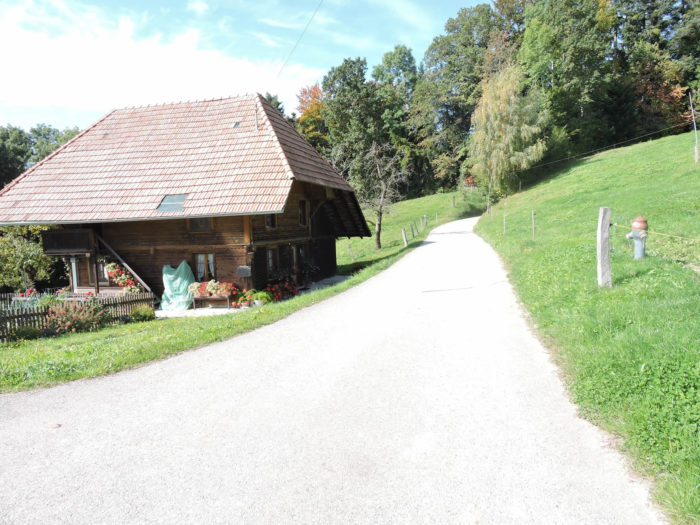 |
 |
The forest route then becomes a wide path, quickly traversing this dense woodland as if to unravel its mystery.
|
 |
 |
Emerging from this green odyssey, the Via Jacobi rejoins the road to Lueg, meandering to the Kaltacker hamlet.
|
 |
 |
| Here, there are no farms but rather stately and tranquil mansions, one of which transforms into a restaurant, silently pondering the local culinary traditions often evoking deer. |
 |
 |
| However, farms abound, always nearby, some adorned with paneling, others with shingles, but most adorned with old wood that tells the years. Geraniums add their glowing touch to this living tableau, these houses designed to withstand time. |
 |
 |
| Then, it’s a long walk along the road, through meadows and fields towards Burgdorf. There, crops dominate, mainly corn, an essential winter supplement for livestock. These are not villages you pass through here, but rather named places where solitary farms punctuate the landscape. |
 |
 |
| At a farmstead, at the Sonnberg Neuhaus location, under the complicit gaze of Simmental cows, the asphalt gives way to packed earth. The path, almost capricious, then sways upwards towards the forest. |
 |
 |
On the small hill, the panorama unfolds, revealing the Bernese countryside, expansive and timeless.

Finally, the path reaches the Weid location. Here, the ways diverge towards Burgdorf. Via Jacobi 4 turns towards Summerhus, choosing not the direct route, but the one that meanders to the right, inviting and mysterious.

Section 6: Burgdorf, a city at the end of the countryside
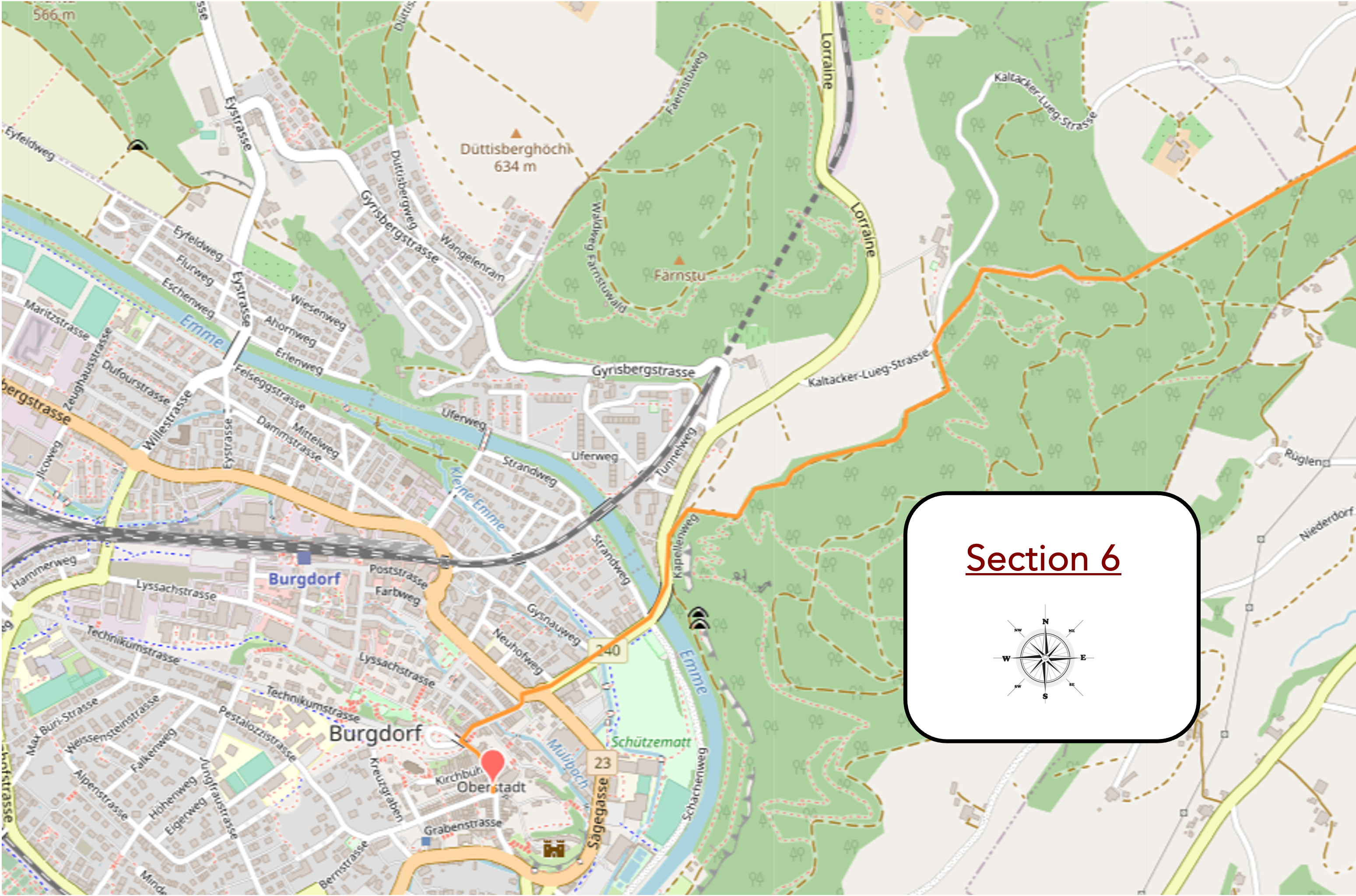
Overview of the route’s challenges: steep descent.

| A trail then plunges into the majestic beech forest of Leuehölzli, wandering for a moment at the edge, between shadow and light, in the neighboring meadows. |
 |
 |
| Further on, it merges again into the heart of the wild nature, gracefully meandering among the tall grasses, making its way under the dense canopy of trees, often young beeches, struggling for their place in the sun. |
 |
 |
| Suddenly, the terrain’s steepness is felt. A sign, ignored by daring mountain bikers, prohibits passage to bicycles. And with good reason, as the slope becomes steep, although apparently not dangerous. |
 |
 |
| The trail, often rugged, fluctuates between 15 and 35% gradient, sometimes carving through marl formations. Underfoot, the earth turns into compact clay, dotted with small stones, offering a rewarding tactile experience. |
 |
 |
| And as often happens, after the trial comes comfort. The trail, like a fugitive emerging from its lair, suddenly opens up at the foot of the descent, at the charming location of Sommerhaus, where a Gasthof with its panoramic terrace reigns. This establishment, popular among the local population, just a stone’s throw from Burgdorf, attracts guests seeking refined cuisine, lulled by the tranquility of the large terrace. |
 |
 |
| From Sommerhaus, the silhouette of Burgdorf emerges on the plain, but Via Jacobi prefers to lead you a little further, through the shaded woods… |
 |
 |
| …before entering the outskirts of the city. |
 |
 |
| Exiting the woods, Via Jacobi 4 crosses the Emme River, an emblematic river of the Emmental and the famous cheese that bears its name. The Great Emme, which gives its name to this Bernese region, originates in the Prealps and flows into the Aare, not far from Burgdorf. It shouldn’t be confused with the Little Emme, followed in the canton of Luzern. While the Emme is not navigable, it was once the main axis for timber rafting, often accompanied by cheese and livestock, a tradition dating back to the Middle Ages. Until the 16th century, only one bridge spanned the river in Burgdorf (Berthoud in French). |
 |
 |
| The journey leads through a vast park. Proudly standing on one of the hills of the old town is the Burgdorf Castle, one of the illustrious remnants of the great feudal fortresses. According to accounts, its construction dates back to the time of the Berthold family of Rheinfelden, even before the era of the Bernese Zaehringen, in the 11th century. It is supposed that around 1200, the Zaehringen undertook renovations of the castle, also erecting the upper town and its church. Over the centuries, the castle underwent transformations without altering its marked medieval appearance. At the end of the 18th century, the educator Pestalozzi established his school there, perpetuating its historical role. Since 1804, the castle has housed the authorities, remaining an immutable witness to history. |
 |
 |
| The Emme, too, veers into an inner course, crossed by the magnificent wooden bridge of Wynigebrügg. Since the Middle Ages, the river, carrying countless pebbles, was detrimental to the mills erected on its banks, leading to the creation of numerous diversion channels. |
 |
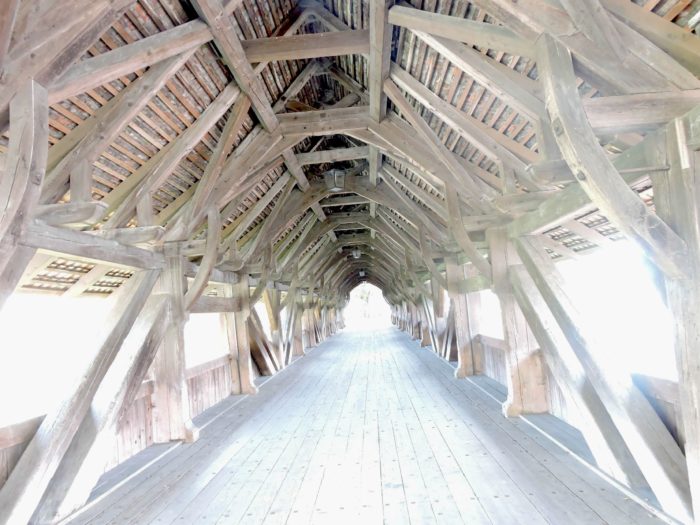 |
| The Via Jacobi then reaches the lower part of the city. Burgdorf, with 16,300 inhabitants, reveals itself as a city in two parts: the old town crowning the heights, and the lower part, bustling around the train station. The bustle seems concentrated around the station, with its shops and restaurants, where the Berchtold hotel reigns supreme, attracting the youth eager for encounters. Founded before 1175, Berthoud and Huttwil in 1313 testify to the region’s ancient roots, where even isolated farms likely existed. The demographic pressure of the 16th century led to the occupation of riverbanks, previously deserted, and the clearing of high pastures. Prosperous in the Middle Ages, Burgdorf experienced a decline in the 17th and 18th centuries, with its artisans preferring agriculture and cheese to industry. At that time, Langnau in Emmental enjoyed a prestigious reputation, based on its exports of linen, cheese, timber, and horses. However, from the 19th century onwards, Langnau and its emblematic region lost their luster to Burgdorf, closer to Bern and its industries. Today, the Emmental, although not legally defined, remains a region with an essential role in asserting a peasant identity. |
 |
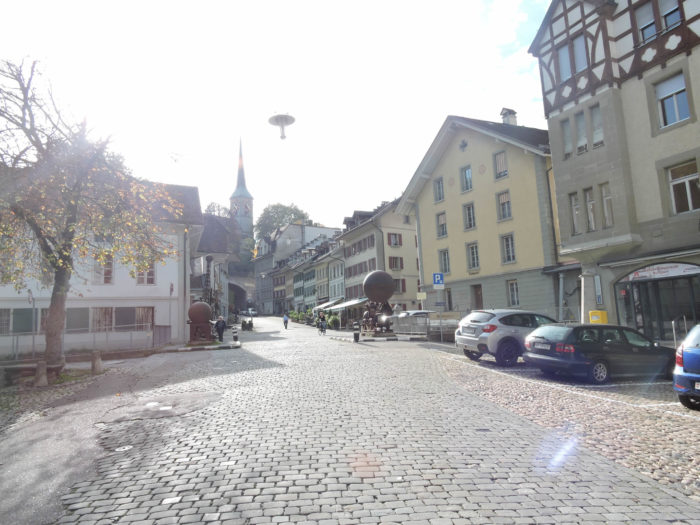 |
| To reach the upper town, you can take stairs or charming small roads winding up the hill. At the top of the steps, Via Jacobi 4 of Burgdorf resumes its course. |
 |
 |
Dominating the city, the Stadtkirche church, built at the end of the 15th century, stands proudly. Its imposing tower, rising 70 meters high, stands out from afar. In Gothic style, it houses magnificent organs. During the Reformation, all ornaments and altars were removed, giving the building a singular austerity, a witness to the Reformed tradition of the canton of Bern.

From the church square, the gaze wanders towards a sumptuous patrician mansion nestled in a green setting below.

| From the church or the castle, picturesque cobblestone alleys descend towards the heart of the old town. |
 |
 |
| In this ancient quarter, houses, with discreet elegance, display a uniform gray hue, punctuated here and there by arcades adorning the streets, a typical characteristic of towns in the canton of Bern. |
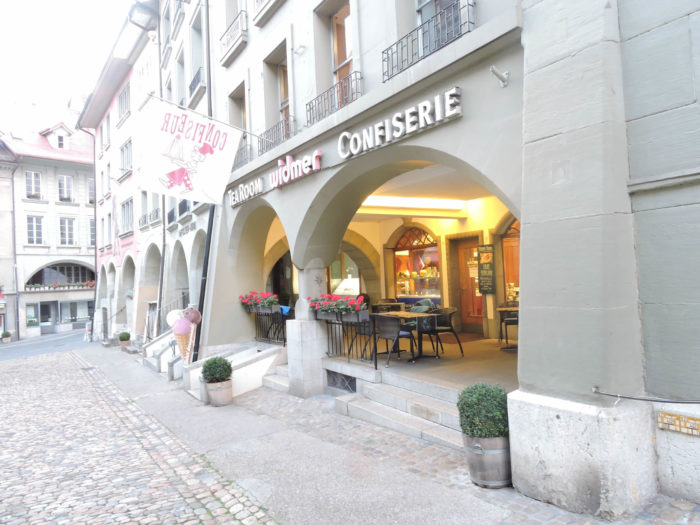 |
 |
Accommodation on Via Jacobi
- Landgasthof Bären, Dorf, Dürrenroth; 062 959 00 88; Hotel, dinner, breakfast
- Hotel Koi-Garteenteich; Häusernmoos; 034 435 16 37; Hotel, dinner, breakfast
- Langgasthof Lueg, Kaltacker; 034 435 18 81; Hotel, dinner, breakfast
- Shloss Burgdorf, Burgdorf; 034 426 10 20; Youth hostel, dinner, breakfast
- B&B Aenmestrand, Schönauweg 12, Burgdorf; 034 422 90 63/079 364 09 83; Guestroom, breakfast
- Hotel Landhaus, Sägegasse 33, Burgdorf; 034 422 29 92; Hotel, dinner, breakfast
- Hotel Berchtold***, Bahnhofstrasse 90, Burgdorf; 034 428 84 28; Hotel, dinner, breakfast
Today, in these regions, finding lodging is not a concern. The route is dotted with dining establishments, with each stop revealing a new gastronomic treasure: one in Dürrenroth, another in Häusernmoos, and yet another in Lueg. However, there are no supermarkets along the way, except for a cheese shop in Dürrenroth, where local delicacies are showcased. This stage is mainly lined with modest hotels, though never at a low price, such is Switzerland. Burgdorf, on the other hand, emerges as a town where shops flourish at every corner. Nevertheless, caution is advised: make reservations even if amenities seem plentiful.
Feel free to add comments. This is often how you move up the Google hierarchy, and how more pilgrims will have access to the site.
|
 |
Next stage : Stage 13: From Burgdorf to Boll |
|
 |
Back to menu |












